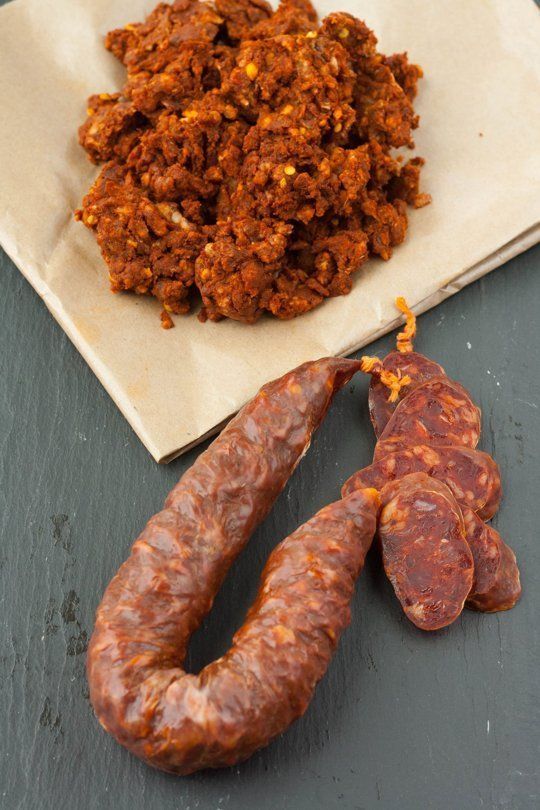
Chorizo - more variety than you think...
In the United States (especially in the Southwest) Chorizo is best known as a spicy, bright red, uncured ('raw') pork sausage found in the Mexican market but there are numerous varieties of this wonderfully flavorful sausage (both cured and uncured) each with their own regional flavor and differing texture produced around the world.
Chorizo
(Chuh-REE-Zoh; Spanish) or Chouriço
(Sure-REET-Zoh; Portuguese) is popular throughout Central and Latin America (especially in Mexico) as well as on the Iberian Peninsula in both Spain and Portugal. Chorizo and Chouriço is used to add color and flavor in everything from tacos, nachos, burritos, and enchiladas to soups, stews, salads, sandwiches, and all kinds of bean dishes.
As already stated, there are numerous versions of Chorizo and Chouriço produced around the world each differing in flavor and texture but to make things simple, all of them can be broken into three basic categories: Spanish style Chorizo, Mexican style Chorizo, and Portuguese Chouriço -
Spanish Chorizo
Spanish style Chorizo
is almost always a dried and cured sausage in a casing generally with a very dense and almost chewy texture. It is typically made using good quality coarsely chopped pork and pork fat along with other ingredients such as garlic and herbs but is ALWAYS seasoned with pimentón
(smoked paprika) which gives it its vibrant color. It is typically classed as either picante
(spicy) or dulce
(sweet) depending on the characteristics of the pimentón used in its production. It can be either smoked or unsmoked and is produced in short, long, hard, or soft varieties with varying lengths of aging.
Unfortunately, here in the U.S., you typically won't find a large variety of Spanish Chorizo variations at your local purveyor, if they offer more than one style it is most likely going to be limited to either spicy or mild but that is typically all you will ever need to make almost any recipe out there.
The fact that Spanish Chorizo is almost always cured (with the exception of Chorizo Fresco) means that it does not require further cooking and can be eaten as is, casings and all, OR heated through OR 'cooked' as part of another dish.
As a cured meat product, Spanish Chorizo can usually be found alongside other ready-to-eat cured meat products like salami, pepperoni, and prosciutto (in other words, typically in the deli area) when available.
Being a cured 'ready-to-eat' sausage means that Spanish Chorizo is commonly served warmed or at room temperature alone or as part of an appetizer - They are often served as Tapas throughout Spain.
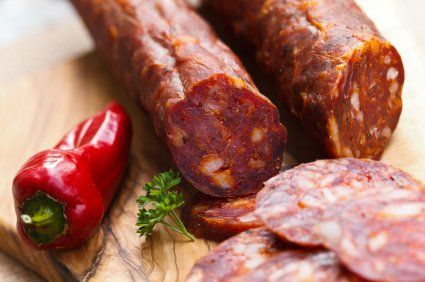
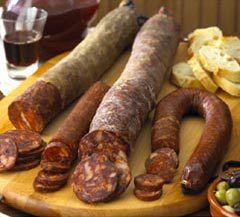
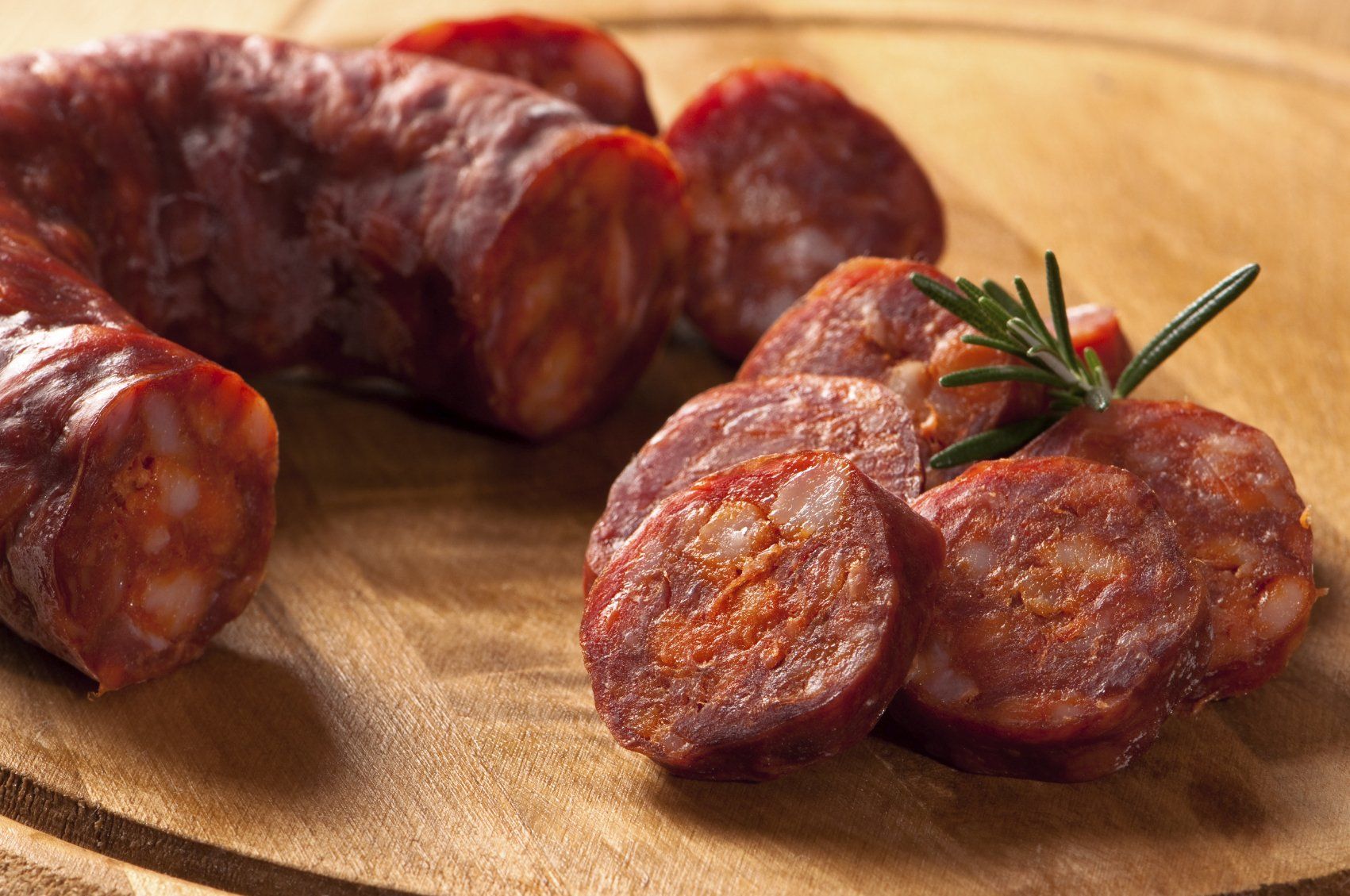
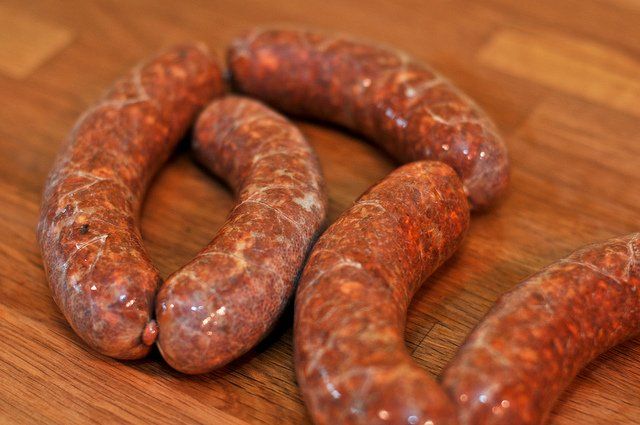
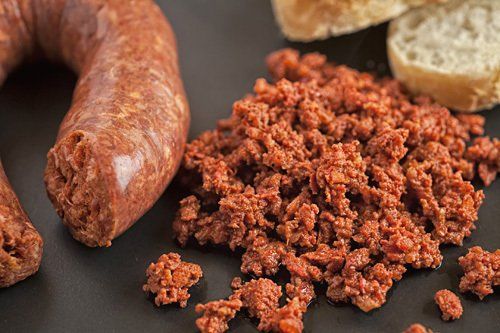

Mexican Chorizo
Mexican Chorizo
is based on the uncured Spanish Chorizo Fresco
and is a highly seasoned, spicy, ground (as opposed to chopped) meat sausage usually made from pork but other meats, such as beef, chicken, and turkey can be used. Though some 'dry' or cured varieties are produced, Mexican Chorizo is most commonly sold fresh and uncooked, either loose or in a casing alongside other raw meats or sausages at the grocery store or market (in other words, in the butcher section) and, almost always, must be cooked before eating. Even though it is commonly sold in a casing, recipes usually call for the meat to be removed from the casings and crumbled in the pan before being cooked.
Mexican Chorizo is almost always made using native chile peppers (as opposed to pimentón
- smoked paprika) along with other herbs and spices typically giving it bright or dark red coloration. Quality Mexican Chorizo is made from good cuts of meats stuffed inside natural (intestinal) casings but there are a number of commercial and 'value' brands made with 'questionable' cuts of meat and utilizing inedible, plastic casings that resemble breakfast sausage links which are, frankly, not anything worth eating - so be sure and find the 'good stuff' to experience what Mexican Chorizo should taste like.
Though most purveyors only carry the typical 'red' Mexican Chorizo, there is a 'green' variety of Mexican Chorizo (Chorizo Verde) made with tomatillos, green chiles, and cilantro (among other ingredients) that originated in the Valle de Toluca
region of central Mexico. This 'green' chorizo still tastes like what you think chorizo should taste like (spicy and savory) but with a 'freshness' that the 'red' varieties are missing - if you can find it (or want to make it yourself) I highly recommend giving it a try; Chorizo Verde fried up with some eggs makes for an incredible filling for breakfast burritos or tacos!
Portuguese Chouriço
Portuguese Chouriço
is very similar to Spanish style Chorizo
in that it is almost always a dried and cured sausage in a casing generally with a very dense and almost chewy texture. The real difference between the two is the sheer variety of regional Chouriço flavors and the fact that Chouriço almost always contains wine as part of its ingredients (in Latin America, it is common for vinegar to be substituted for the wine when making Chouriço recipes).
With all of the differences in wine, the length of cure, the length of time spent smoking, and variations in ingredients, Chouriço has the largest number of 'standardized' regional flavor variations ranging from 'sweet' to 'spicy' and in color from pink to black. The flavor of most Chouriço tends to be heavy on the garlic but is commonly substituted with Spanish Chorizo in areas where traditional Chouriço is not available and is claimed to be interchangeable by most cooks.
In the U.S., Chouriço is rarely found for sale outside of areas with a heavy Portuguese population but, if available, can be used in the same manner as Spanish Chorizo in almost any dish - BUT using the 'real deal' adds that touch of tradition and authentic flavor to Portuguese cuisine and its dishes that call for it.
Much like the Spanish Chorizo, because it is a cured 'ready-to-eat' sausage, Chouriço is often served warmed or at room temperature either alone or as part of an appetizer - one popular way to serve chouriço in Portugal (and Portuguese restaurants) is the dish known as Chouriço Flambé where sliced or scored chouriço sausages are presented to the table on alcohol-fueled, terracotta braziers (often pig-shaped) where it is then flame cooked until well blackened by either the waiter or left for the diners to do themselves.
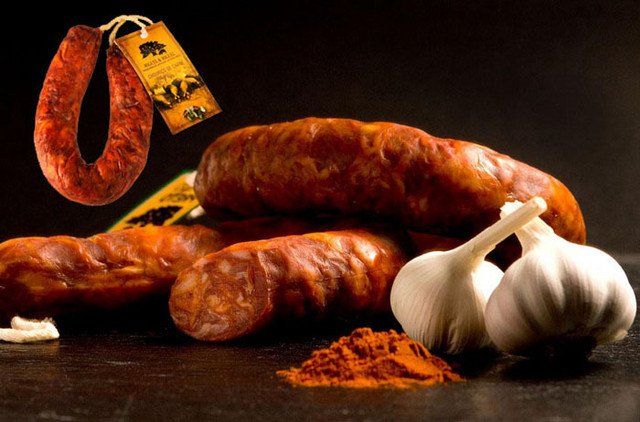



So now that you know the differences, which do you use if a recipe calls for 'Chorizo' with no qualifier? Just read the recipe...
If the recipe instructions call for the chorizo to be taken out of its casing and crumbled or mixed with other raw ingredients then it is the Mexican Chorizo (or Chorizo Fesca) that you want.
If the recipe instructions call for the chorizo to be chopped or sliced before being added to the dish then Spanish Chorizo or Chouriço is what you want.
Since it can be difficult to find, and is commonly substituted by Spanish Chorizo in recipes, Chouriço is a little trickier to decipher when it should be used to make a dish 'authentic'. Many recipes if they do not call specifically for Chouriço will call simply for 'Chorizo' - in this case, obviously the above rule still applies in deciding if you need Mexican Chorizo or Spanish Chorizo / Chouriço. Once that is settled, deciding between the Spanish Chorizo and Chouriço takes a little extra research -
You need to find the origin of the dish. If the dish is Portuguese or originated in Portugal before being transported to other parts of the world then Chouriço is more than likely the traditional and/or intended ingredient. If you cannot find the origin of the dish, then go ahead and use whichever you have on hand (Spanish Chorizo or Chouriço); as said above, they are commonly used interchangeably!

Here in Arizona (being part of the Southwest and so close to Mexico), finding Mexican Chorizo obviously is not an issue. There are numerous Mexican markets and Supermarkets that carry quality Mexican Chorizo all over the state - it should be easy to find one that you like the flavor and heat level.
As for Chouriço and Spanish Chorizo - I have not found Chouriço for sale anywhere in Arizona, but you CAN order it online and Spanish Chorizo CAN be purchased at
Whole Foods,
AJ's Fine Foods, and at
Schriener's Fine Sausages which is
located in Phoenix at the Northeast corner of
7th St and Whitton Ave - on the web @
http://www.schreinerssausage.com/
Wherever else you may be in the country or the rest of the world the popularity and availability of any of these may differ so you will have to do some research, shop around, and find what you can where you can - in some areas it will be easier to find one or more of these than in others depending on population and the local 'food culture'.

